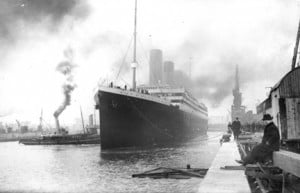This Saturday night and into Sunday is the 100th anniversary of the sinking of the Titanic. Because so many Facebook and Twitter updates show that some kids today don’t know that Titanic was real, here is a little history of the actual event.
The Titanic was the flagship of the White Star Line, the largest and most luxurious sailing ship ever made up to that time. It was the largest ship on the water, beating out the former record holder by 100 feet. The Titanic could carry 3,547 people, of which 2,435 were passengers. On its maiden voyage, it was carrying about half its capacity with 1,320 passengers and 907 crewmembers.
The ship was organized into three classes: first, second and third. The first class accommodations were incredibly luxurious, with promenade suites (like the one Rose stayed in with a private open air promenade deck) at $4,350 for a one-way ticket. That’s $104,760 by today’s standards! Even the third class accommodations were much nicer than other ships at the time, and much nicer even than many of their own homes.
The ship left port from Southhampton, England around noon on April 10, 1912. After stopping in Cherbourg, France a few hours later to take on passengers and then stopping again for passengers and supplies in Queenstown, Ireland (now Cobh, Ireland) on April 12, she set out for New York across the North Atlantic.

On April 14, Titanic radio operator Jack Phillips received six iceberg warnings from other ships including one at 10:30 p.m. from a nearby ship that had stopped for the night due to the icy conditions. Phillips responded to this warning by cutting the other ship off saying, “Shut up! Shut up! I’m working Cape Race.” Cape Race, Newfoundland was handling all the transmissions from Titanic passengers. Phillips was busy sending private messages for passengers and he paid no heed to the several warnings, most of which never made it to Capt. E. J. Smith.
Titanic struck an iceberg just 20 minutes before midnight on April 14, 1912. Due to low visibility (no moonlight), no binoculars for the watchmen and a calm sea (couldn’t see the waves lapping on the edges of the bergs), Frederick Fleet and Reginald Lee, who kept lookout from the crow’s nest, didn’t see the iceberg directly in their path until it was too late. Rather than ramming straight into the berg, which may have damaged the bow but saved the vessel (Titanic’s sister ship Olympic rammed and sank the Uboat U103 with its bow and remained afloat ), First Officer William Murdoch, who was in command at the time, decided to call a “hard-a-starboard” to try and turn to the left. He also rang “full astern” to put the engines in reverse. This caused the ship to slide along side the iceberg, making impact at 11:40 p.m., April 14, 1912. The iceberg, once thought to have gashed the hull of the ship, is now believed to have repeatedly struck the hull, bending the steel plating and popping the rivets, allowing water in to flood the compartments.
At 12:05 a.m. the order went out for evacuation. The passengers were roused from their cabins and told to put on their life belts had meet on deck. Many didn’t comply, taking the warning as a joke and instead decided to play soccer with the chucks of ice on deck.
Capt. Smith was faced with the hard fact that there weren’t enough life boats to save everyone on board. There were a total of 20 life boats, each tested for 68 people having a total capacity of 1,178 people total – about half of the amount on board, and about one third of the number Titanic was licensed to carry. The White Star Line, however, decided that they would have fewer life boats to give a wider deck space and an unencumbered view of the sea.
This crushing reality made Capt. Smith despondent, hindering his ability to perform his duties. He didn’t give any orders, didn’t oversee anything. He didn’t even inform his crew of the circumstances. Some crewmembers only knew there was a problem when they saw a life boat floating away from the ship and called in to ask why.
The Titanic sank in only two hours and 40 minutes after impact at 2:20 a.m. on April 15, 1912. She was the largest commercial ship at the time and when she sank, according to the British Board of Trade report, 1,514 people went down with her. Only 710 out of 2,224 souls aboard were saved; 68% of the total passengers and crew lost their lives on Titanic.
This week we can remember those lost. Whether by observing a moment of silence or taking part in a Titanic tea on April 20, however one chooses to commemorate this event – take some time to remember those who died.
This reporter will be heading to the pub to drink a toast to those lost on Saturday night around 11:30 p.m. If you would care to join, please feel free to meet us at Gilligan’s this Saturday.

